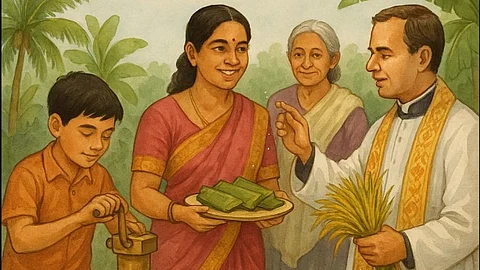

The staple food of Goa is Rice, fish and curry. The cultivation of rice begins in the month of June and the crop reaches maturity by mid of August which is ready for harvesting during the months of September and October. Families made sure that they had stocked up enough of jaggery and parboiled rice sufficient for preparing something sweet on the onset of August. It has always been customary in every Goan home to prepare something sweet on the first day of August. However, whenever the sweet was made children generally just enjoyed the process of making the sweet and gulping it down their throats. Most of them never actually bothered asking what the reason for doing what we did was!! It is necessary that children spend time with their grandparents, getting to know different stories behind practices that have been carried out down the generations. By doing so we become aware and also understand things happening around us in a much better way. A grandmother, Mrs. Joyce Carvalho e Aguiar mentions that the month of August is known for celebrating newness.
But what’s really new in August? Well it is the paddy crop which is on its way to maturity and gradually to the date of its harvest. It is the new harvest. Hence the month of August is known for celebrating newness or ‘novidade’. Infect, it is a tradition that one sets one’s step into the month of August with something sweet to eat. Traditionally on the first day of August, every Goan family would prepare ‘Shevyo’. These are rice vermicelli, mixed with grated coconut and palm jaggery. ‘Shevyo’ can be prepared by placing steamed rice cakes into a vermicelli maker (Shevgo) either made of wood, iron or brass. Mind you!!! Not every family would own a ‘Shevgo’. If you didn’t have one then you had to borrow one from your neighbor or sometimes even rent it out for a day. Those families that didn’t prepare ‘Shevyo’, ensured that they didn’t deprive their taste buds, of something sweet, on the first day of August, by at least biting into a piece of Jaggery.
Different parishes in Goa celebrate the ‘novidade’ on different dates in August. On this day the parish priest of the church (Pádre Vigário) visits a demarcated paddy field and blesses the new crop. A bundle of blessed paddy sheaves are then brought to the church where they are distributed among the congregation (one sheave per family). The family then places this blessed paddy sheave onto their family altar or oratory (sheaves of the previous year are burnt). The mother of all celebrations is that, carried out in Raia a village in South Goa on the occasion of the feast of Our Lady of Snows, on 5th of August, every year. On the 10th of August, the parish of Sinquerim, North Goa, dedicated to Saint Lawrence, celebrates the ‘novidade’. Most of the parishes across the state celebrate the ‘novidade’ on the 15th of August, i.e. the feast of Our Lady of Assumption. Every Catholic family prepares ‘Patolleo’ (a rice dumpling stuffed with grated coconut and jaggery, generally wrapped in a turmeric leaf). According to local myth about making ‘Patolleo’, if the droplets of steam from the copper or terracotta steamer (Copro), used to steam the ‘Patolleo’, falls on to the skin, of the person steaming the ‘Patolleo’, the person would be susceptible to getting ‘Chamkil’ (warts). Finally the last day for celebrating the new harvest is on 24th August, the feast of Saint Bartholomew, celebrated on the following Sunday (if 24th happens to be a weekday) in parishes like that of Betalbatim, South Goa, where the parish church is consecrated to Saint Bartholomew. If at all a family was mourning for someone within their house, the family members were not allowed to use the ‘Copro’ for steaming any food item. Hence the morning family would be offered something sweet by their close neighbours.
Other sweets prepared in the month of August, include ‘Folle’ which are cone shaped rice dumplings prepared in cones woven out of Jackfruit leaves and ‘Aatol’ a semisolid cake comprising of Palm jaggery, grated coconut, split chickpea, and wheat. ‘Aatol’ was prepared especially on the day of harvesting the crop. Apart from preparing it on the day of harvesting one’s field, the sweet was also prepared on several other occasions like, on the day the foundation stone for a new house was layed and on the day of raising the first beam of the house (paati), onto the roof. ‘Goddshem’ is a liquid variation of the ‘Aatol’ and was made on several occasions like weddings. Mrs. Joyce also mentions about an interesting proverb ‘Agosto, bom gosto ou Agosto disgroso (desgraça?)’, which probably meant that August is the month full of loads of good tastes (sweets?) but also was a month of utter disgrace for families which ran out of food (paddy), before the new crop was ready to be harvested.